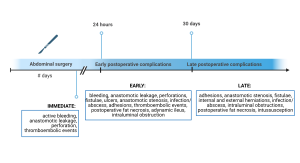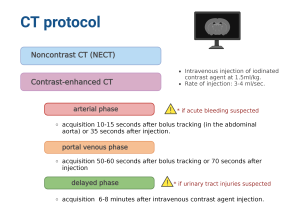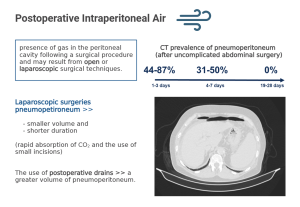In the postoperative period, radiologic imaging is essential for identifying and differentiating common and expected postoperative imaging results from potential complications. For radiologists, the early postoperative phase can be difficult since normal findings and problems frequently share traits. Numerous issues may arise throughout all surgical procedures, while others are particular to the specific operation conducted.
Types of postoperative complications are variable and depend on:
- Type of surgical procedure
- Indication for surgery
- Severity of presentation
- Comorbidity conditions or concomitant disease entities
- Timing in relation to the operation
- Length of the postoperative period
It is essential to recognize and differentiate between a typical or predicted postsurgical presentation of the performed procedure early. Fig 1 shows the temporal evolution of surgical complications.

In the earliest postoperative phase and/or for critically hospitalized patients, computed tomography (CT) is the predominant imaging modality; however, alternative modalities such as ultrasound, MRI, and nuclear medicine are emphasized for certain circumstances. Due to its ability to precisely describe gas and fluid collections, contrast-enhanced CT is a frequently employed imaging modality for postoperative patient evaluation.


This work overviews the typical imaging findings following abdominal surgery and the radiological approach for evaluating the most common postoperative complications, including general, hepatobiliary, pancreatic, and gastrointestinal surgery.